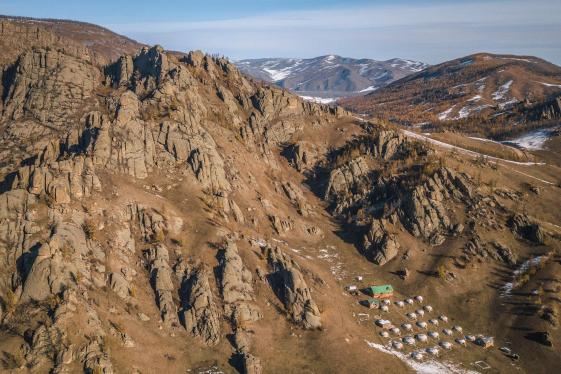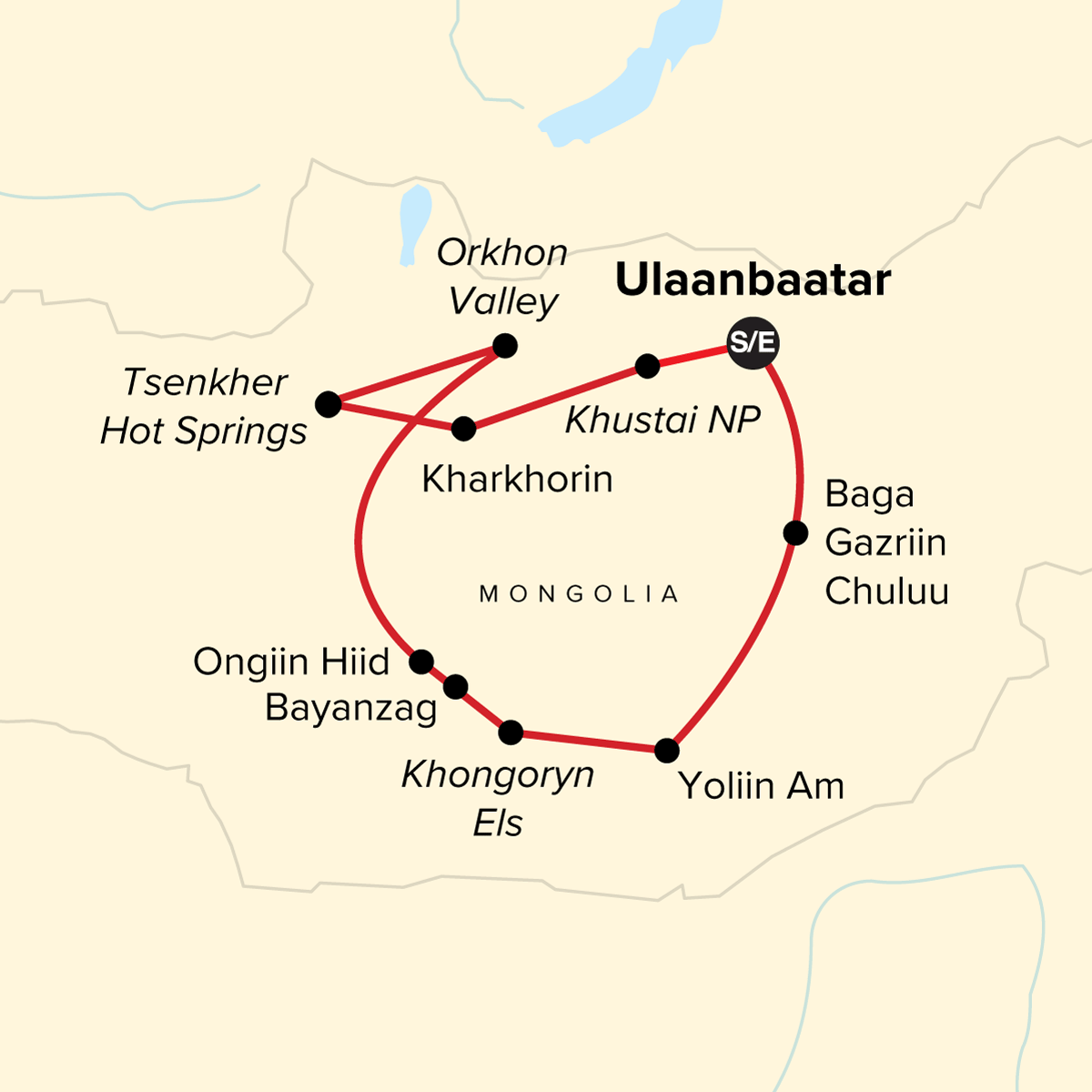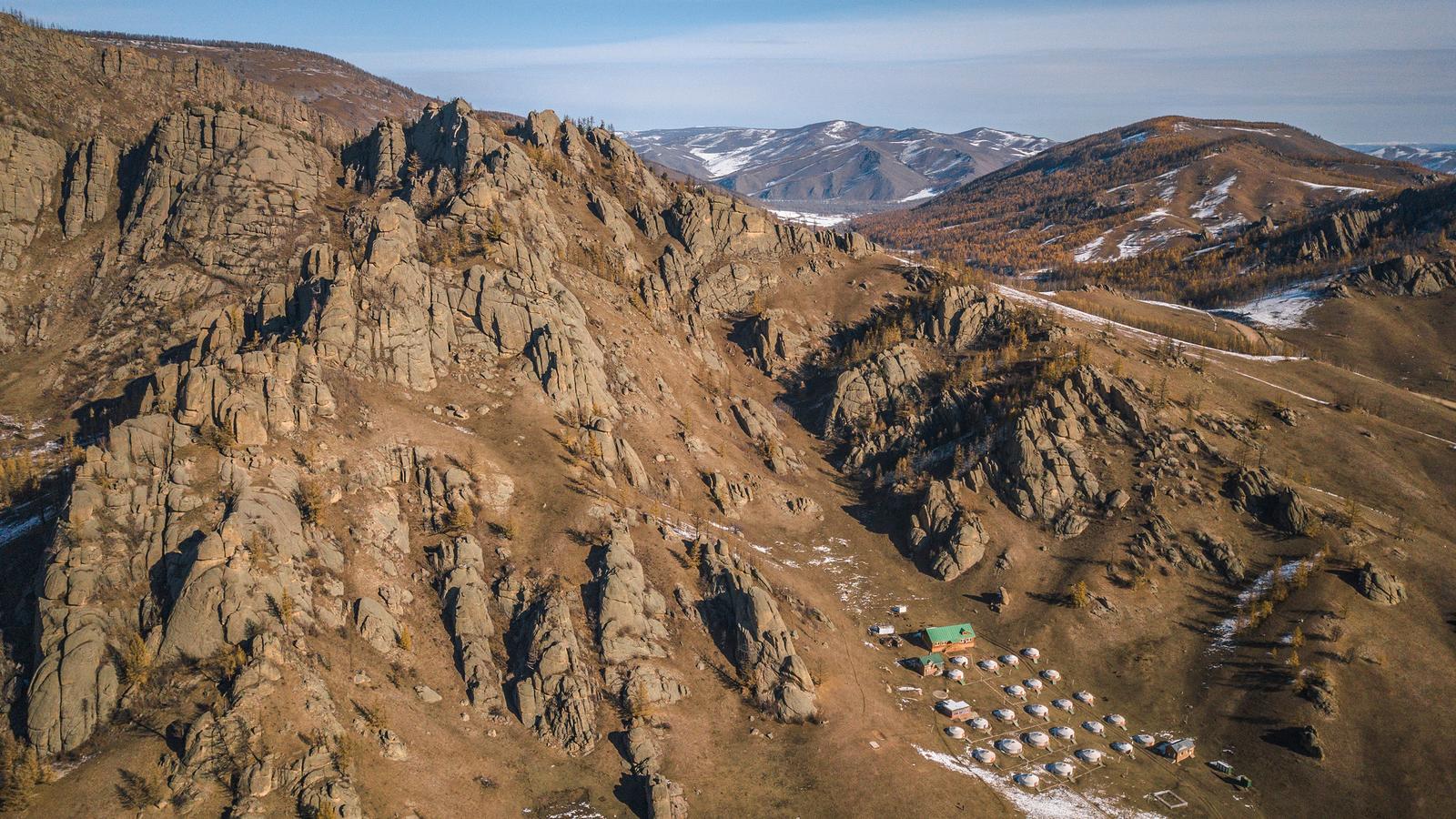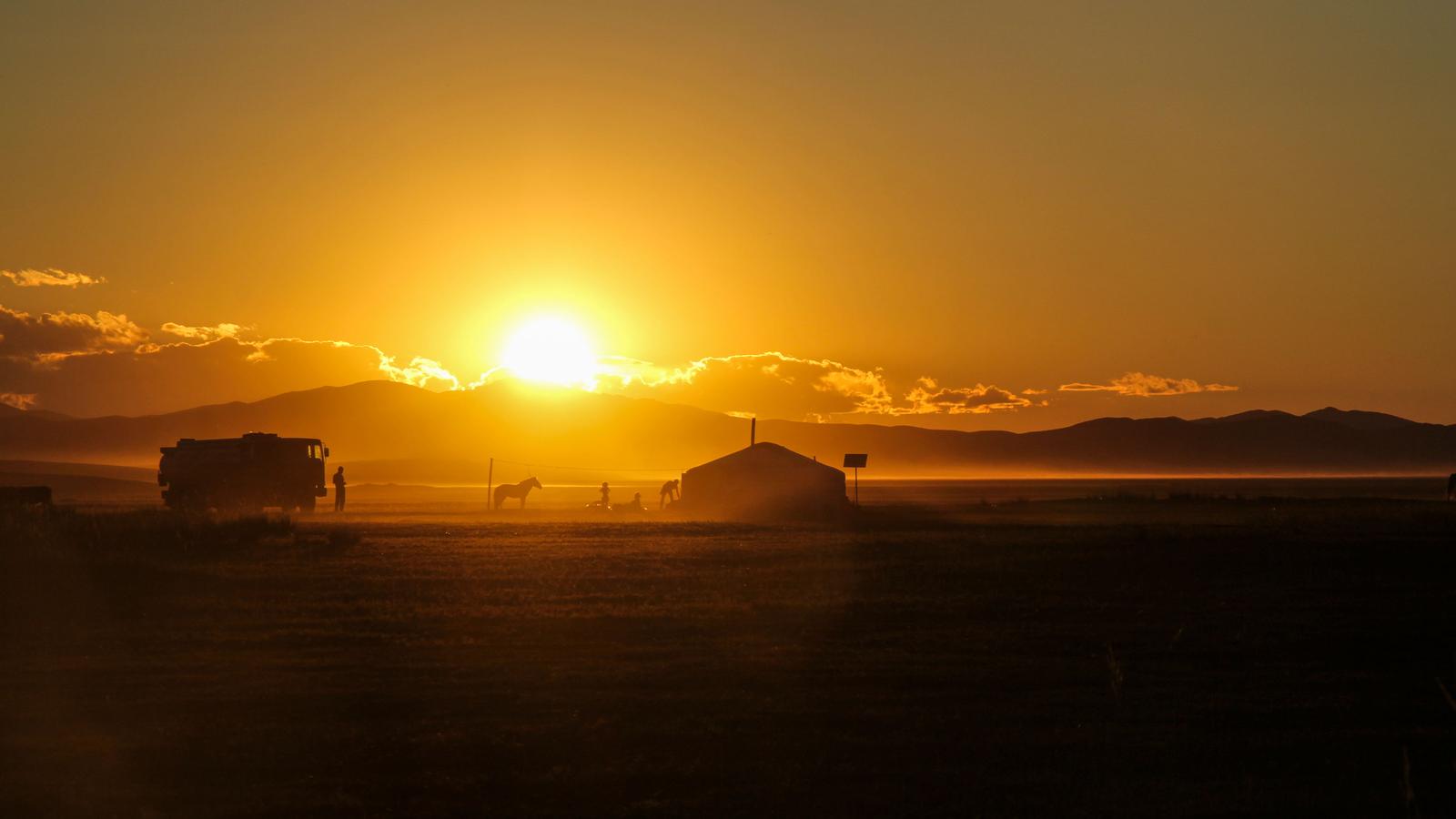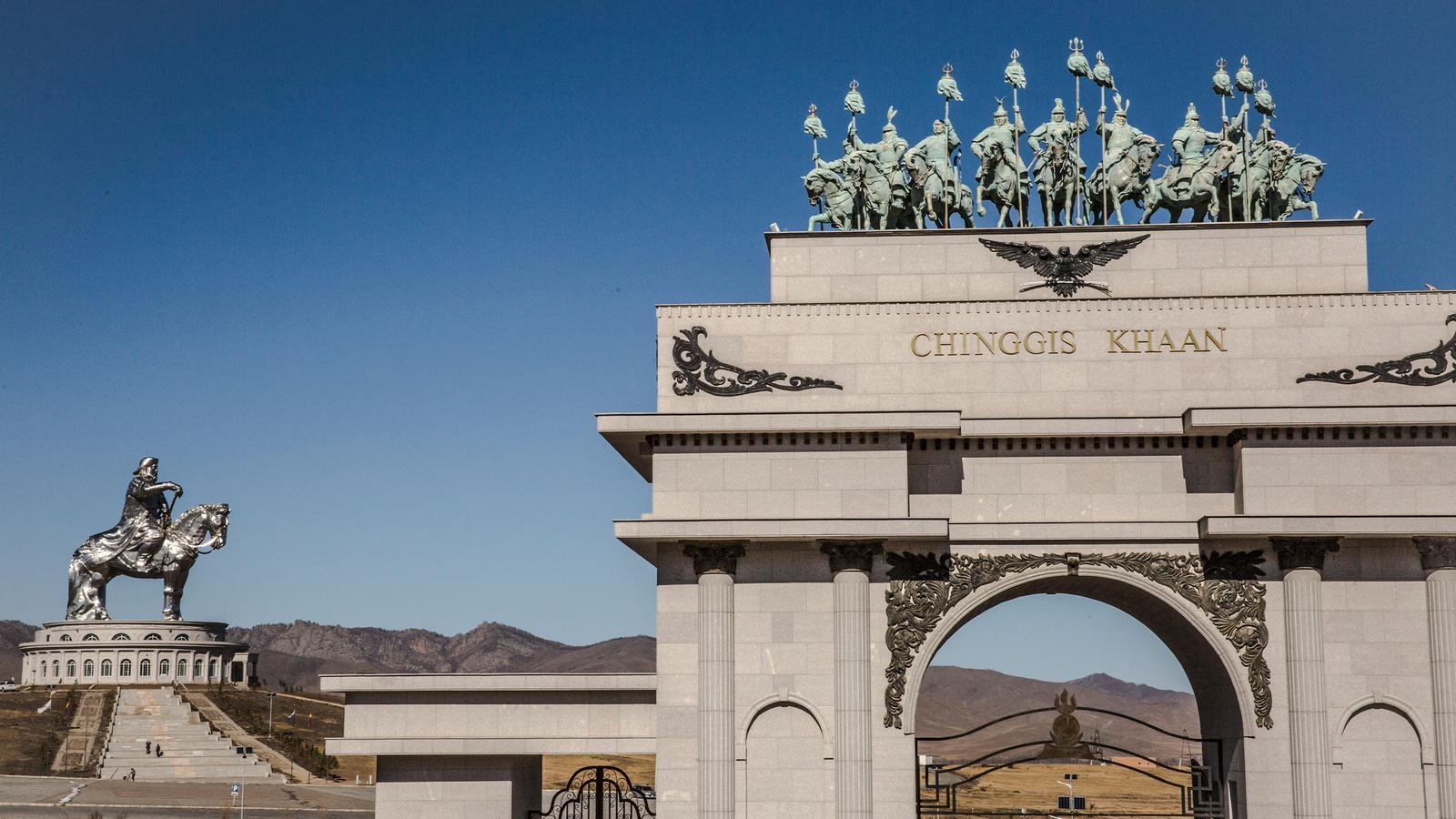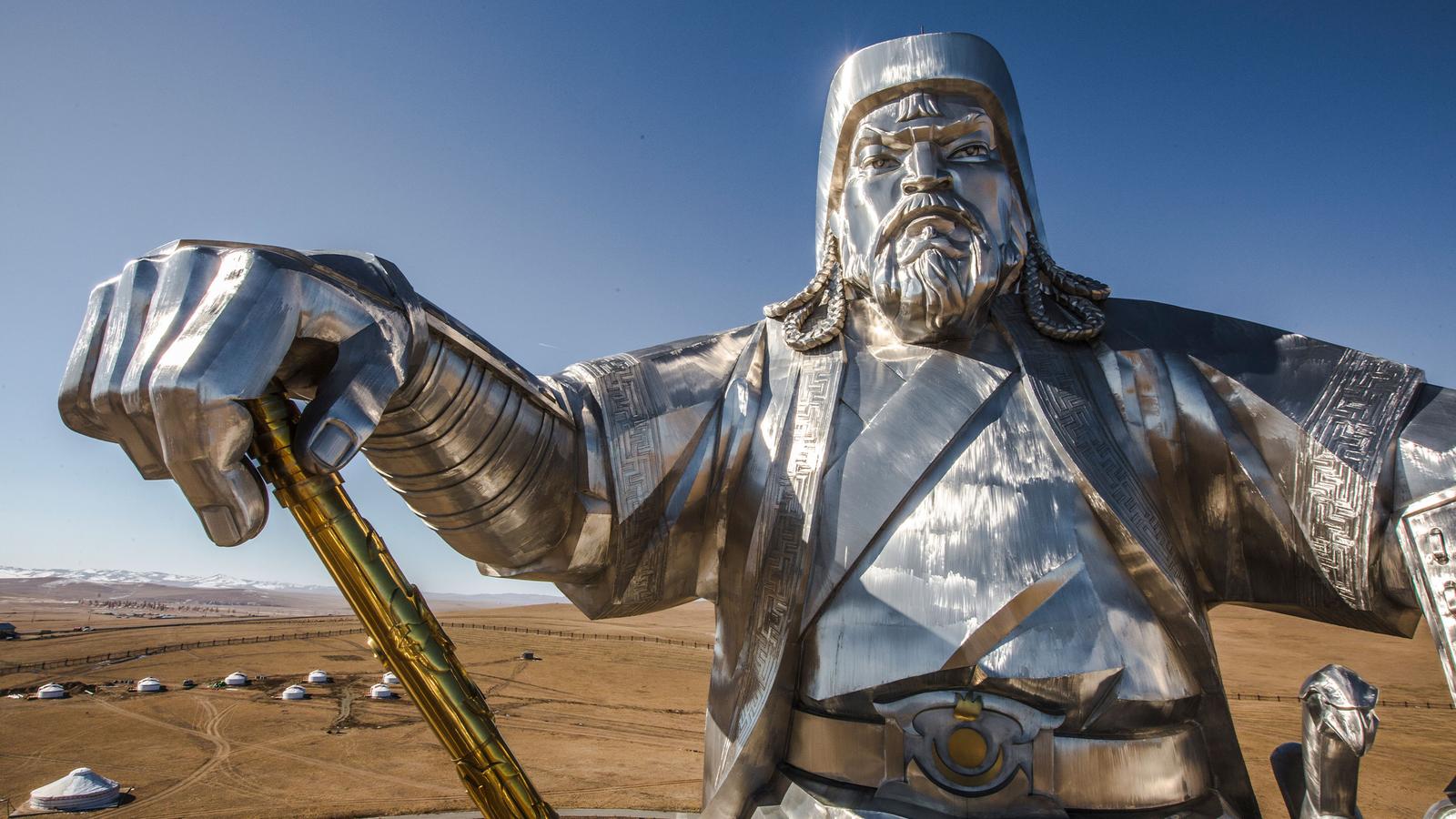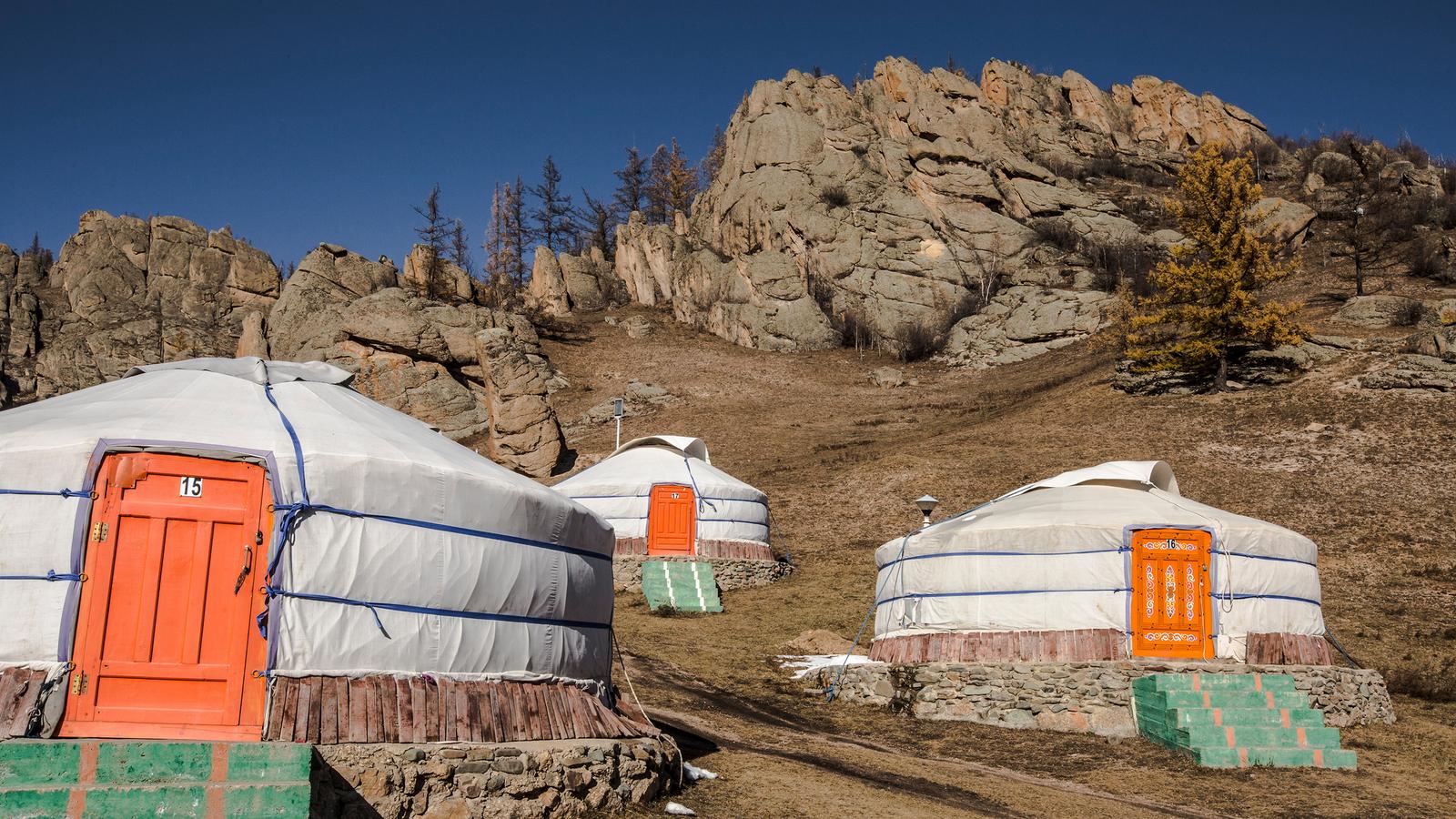Journeys: Discover Mongolia
Duration: 14 days
Begins: Ulaanbaatar
Ends: Ulaanbaatar
Trip Code: AMENG
From
£3,749 per person
Overview
- Your Journeys Highlight Moment: Nomadic Family Desert Ger Building & Archery Lesson Experience, Bulgan
- Your Journeys Highlight Moment: Yak Milking with Herding Family, Orkhon Valley
- Your Journeys Highlight Moment: Yak Family Farm Experience, Orkhon Valley
- Your Journeys Highlight Moment: Erdene Zuu Monastery, Kharkhorin
- Your G for Good Moment: Cafe No Limits Visit, Ulaanbaatar
- National Museum of Mongolia Visit & Tour
- Nalaikh Village Family Ger District Lunch
- Genghis Khan Monument Visit
- Gandan Monastery Guided Tour
- Zorgol Khairkhan Mountain & Picnic Lunch
- Baga Gazriin Chuluu National Park Hike
- Yolyn Am Visit
- Moltsog Els Sand Dunes
- Free time in Bulgan, Elsen Tasarkhai
- Flaming Cliffs Visit
- Ongiin Khiid and Hoshuu Monasteries Visit
- Orkhon Waterfall Hike
- Mongolian Dumpling (Buuz) cooking class
- Khorkhog (Mongolia Traditional BBQ)
- Erdene Zuu Monastery
- Karakorum Museum
- Uvgun Monastery Hike
- Khustai National Park (Khustain Nuruu) Visit
- Mongolian Cultural Show
- Arrival Transfer
- All transport between destinations and to/from included activities
Hotels (3 nts), Ger camps (10 nts).
13 breakfasts, 11 lunches, 11 dinners
Allow USD100-130 for meals not included.
Private vehicles, 4x4, walking, hiking.
CEO (Chief Experience Officer) throughout, local guides.
Full Itinerary
Departure Dates
Day 1 : Ulaanbaatar
Arrive at any time. Arrival transfer is included.
Arrival Day and Welcome Meeting
The adventure begins tonight. Feel free to explore before your welcome meeting, but make sure you’re back in time to meet the group. Check for the meeting time on the welcome note at the hotel. After introductions, your CEO will review the details of your tour. Please note that normal check-in times apply at our start hotels, but you can usually store your luggage for the day if you arrive early.
Private Vehicle
Settle in and scan the scenery from the convenience of a private vehicle.
Acommodation
Grand Hill Hotel
Acommodation
Grand Hill Hotel
Day 2 : Ulaanbaatar
Enjoy a morning tour of Mongolia’s bustling capital. Visit Gandan Monastery, one of the country’s most important Buddhist sanctuaries, and wander the rooms and temples of Bogd Khan’s Winter Palace, the former home of Mongolia’s last king. Climb up to the Zaisan Memorial, a Soviet Era monument which commemorates Russian soldiers killed in World War II, and take in sweeping views of the city from the hilltop. Afterwards, pop in for a visit to No Limits Cafe and enjoy coffee, tea, and snacks prepared and served by local youth with Down Syndrome, and their mothers. Later, admire the world-class collection of fossils at the Central Museum of Mongolian Dinosaurs, dedicated to preserving Mongolia’s paleontological heritage.
Ulaanbaatar City Tour
Visit the highlights of Ulaanbaatar with a guided tour to the Gandan Monastery, Bogd Khan Palace, and Zaisan Hill – where you can take in a bird's eye view of the city.
Gandan Monastery Guided Tour
Discover one of the most important Mongolian temple complexes, the Gandan Monastery. Learn about the history of Buddhism in the region and see if you can spot some chanting monks. If lucky, a local fortune teller may be around to share some wisdom.
Bogd Khan Palace Guided Tour
Visit the Winter Palace of the last king (now a museum) and learn more about life in imperial Mongolia. Tour the six temples, and see clothing, furniture, and royal items from this interesting time period.
Zaisan Hill Visit
Head to the top of Zaisan Hall to see the Russian monument dedicated to Soviet soldiers who died in World War II. Take in a bird's-eye view of the city.
Natural History Museum Visit
The Central Museum of Mongolian Dinosaurs was established to protect, register, and verify fossils, in order to preserve Mongolian heritage for future generations. Dinosaurs of all shapes and sizes once roamed the Gobi desert and some of their fossilized bones and eggs were first found in the 1920s by Roy Chapman Andrews. Walk through this small but excellent museum with an expert guide, learning about the paleontological history of the region.
Cafe No Limits Visit
Pop in for a visit to the No Limits Cafe and enjoy coffee, tea, and snacks prepared and served by local youth with Down Syndrome, and their mothers. The Down Syndrome Association of Mongolia is a non-profit organization that supports children who live with Down syndrome, and their families. The organization focuses on creating community awareness, advocacy, and educational efforts within Mongolia. The No Limits Cafe began as an effort to create job opportunities and training for young people with Down syndrome and their mothers who are often left out of benefitting from economic opportunities. Through the cafe, the program works to break down barriers for people and families living with disabilities.
Acommodation
Grand Hill Hotel
Acommodation
Grand Hill Hotel
Breakfast
Day 3 : ULAANBAATAR/KHUSTAI NATIONAL PARK
Travel by 4x4 to Khustai National Park, where some of the Earth’s last wild horses roam. The takhi or Przewalski’s horse native to these grasslands had nearly vanished from the wild, until the species was reintroduced here as a result of a successful captive breeding program. Meet with park staff to learn about the takhi reintroduction project, and keep an eye out for these stocky, coffee-coloured horses that have never been domesticated. Settle into a ger tonight, a round, felt-covered tent with basic furniture. We will stay in traditional Mongolian lodgings like gers through day 12 of the trip.
This trip covers a lot of ground and we will do so in 4x4 vehicles but there is a lot of driving on some very rough and unmaintained roads. A large part of Mongolia's appeal is its wild, untouched nature and, as such, accommodation and infrastructure can be very basic in nature. As such, hot water and electricity can be uncertain. Mongolia is a country which is very different to anything you will have experienced before and while this means it is not the easiest place to travel, this is also what makes it so special.
Accommodation from day 3 to 12 will be in gers. Gers are traditional Mongolian tents made with wooden frames and layers of felt. The camps we stay at will have 2 beds with mattresses, linens, and extra blankets. The tent is on a platform and while simple, is quite comfortable and offers a truly unique experience. Our locations are remote and gers do not have built-in ensuite - all camps have shared facilities with toilette's/sinks/showers. Most ger camps have 24 hour electricity with a couple of exceptions that have generators which after 11pm they cut electricity until morning.
Private Vehicle
Settle in and scan the scenery from the convenience of a private vehicle.
Khustai National Park (Khustain Nuruu) Visit
Home to the last of the truly wild horses in the world, the park is a wonderful chance to see the Takhi horses in their natural environment. At one point there were none in the wild, but after a hugely successful captive breeding program in various worldwide zoos, they were reintroduced.
Acommodation
Ger Camp Hustai
Acommodation
Ger Camp Hustai
Breakfast | Lunch | Dinner
Day 4 : KHUSTAI NATIONAL PARK/KHARKHORIN
Drive to the city of Kharkhorin and onward to nearby Karakorum, Mongolia’s ancient capital. Here, Genghis Khan established his headquarters in the early 13th century. Explore the remains of the Erdeni Dzu Monastery, considered Mongolia’s earliest centre of Buddhism, and meet with the head monk to learn about the communist purges that decimated much of the country’s Buddhist heritage. Later, visit the Karakorum Museum, which houses an impressive collection of artifacts from the 13th and 14th centuries as well as a scale model of the ancient capital.
Private Vehicle
Settle in and scan the scenery from the convenience of a private vehicle.
Erdene Zhu Buddhist Monastery Entrance Visit
Erdene Zhu is a Buddhist Tibetan monastery dating back to 1585. Built from the ruins of Genghis Khan's capital, it's the oldest surviving monastery in Mongolia today. Visit the monastery to meet one of the monks who live here and learn about Buddhism history in Mongolia. In 1939, the communist leader Horlogiin Choibalsan destroyed the monastery in a purge that brought about the disappearance of hundreds of monasteries in Mongolia and the death of more than 10,000 lamas. Three temples and the outer wall with the stupas remained intact and were transformed in museums in 1947. After the fall of communism in 1990, the monastery was given back to the lamas and Erdene Zhu became a place of worship again, where many pilgrims come to walk and gather their thoughts. The site was restored at the end of the century and almost found back its religious activity. Today, Erdene Zhu remains an active Buddhist monastery, and at the same time a museum open to travellers.
Karakorum Museum
Visit the modern Karakorum Museum, considered one of the best outside Ulaanbaatar. The exhibits display artifacts found from within the area dating from the 13th and 14th centuries. Varied items are on display including statues, a kiln, pottery, and coins. For perspective on the area there also is a scale model of ancient Karakorum.
Acommodation
Ger Camp Munkhtenger
Acommodation
Ger Camp Munkhtenger
Breakfast | Lunch | Dinner
Day 5 : Kharkhorin/Tsenkher
Arrive at Tsenkher in the afternoon, the site of natural hot springs surrounded by serene, forest-covered hills. Popular with tourists and locals alike, these springs have long been known for their therapeutic benefits. Take a soak in one of the outdoor pools, or choose the privacy of an indoor bath.
Private Vehicle
Settle in and scan the scenery from the convenience of a private vehicle.
Tsenkher Hot Springs Visit
Enjoy a soak in the natural hot springs. The place is very popular with both locals and tourists as the hot water here is said to have healing powers.
Acommodation
Duut Mankhan Ger Camp
Acommodation
Duut Mankhan Ger Camp
Breakfast | Lunch | Dinner
Day 6 : Tsenkher/Orkhon Valley
Drive to the breathtaking Orkhon Valley, a UNESCO World Heritage site that encompasses rolling hills and pastureland, traditional pastoral societies, and archaeological remains. Set out on a hike to the lofty Tuvkhun Monastery, founded by the Mongol Buddhist leader Zanabzar in the mid-17th century. Explore the monastery’s wooden temples, integrated with a natural system of caves, and enjoy beautiful views of the Orkhon Valley and surrounding pine forests.
Private Vehicle
Settle in and scan the scenery from the convenience of a private vehicle.
Tuvkhun Monastery
Established in the 1650s by Zanabazar, one of Mongolia's most respected religious leaders, the monastery has beautiful views of the Orkhon Valley and it's surrounding pine forests.
Acommodation
UlaanTsutgalan Ger Camp
Acommodation
UlaanTsutgalan Ger Camp
Breakfast | Lunch | Dinner
Day 7 : Orkhon Valley
Immerse yourself in traditional Mongolian culture on a visit to a local family's goat and sheep farm. Learn about daily life from the family and see how they make some of their food. Then, sample some of their products, including curd and yogurt. Later, enjoy a hike to a picturesque waterfall before returning to your ger camp for a traditional Mongolian barbecue, prepared over hot stones.
Goat & Sheep Family Farm Experience
Visit a local family's goat and sheep farm for a cultural immersion like no other. Get to know the family and learn about their daily life and how they make dietary staples. Step out of your comfort zone and sample some of their products, including curd and yogurt–enjoy a peak into rural life.
Orkhon Waterfall Hike
Pack a camera and hike to the Ulaan Tsutgalan waterfall along the Ulaan River. Marvel at this 20 m high waterfall, the largest in Mongolia, and enjoy the surrounding landscape.
Acommodation
UlaanTsutgalan Ger Camp
Acommodation
UlaanTsutgalan Ger Camp
Breakfast | Lunch | Dinner
Day 8 : ORKHON VALLEY/ONGIIN KHIID
Today, we make our way to the Gobi, one of the world's largest deserts, which covers much of the southern part of Mongolia. Visit the ruins of Ongiin Khiid, a complex of Buddhist monasteries and universities which were tragically destroyed during the communist purges. Tour the site and learn about the monks who have returned here in recent years, bringing new life to the complex.
Private Vehicle
Settle in and scan the scenery from the convenience of a private vehicle.
Ongiin Khiid and Hoshuu Monasteries Visit
Both these monasteries were important centres in the region before they were destroyed. The systematic destruction of religious sights under Communist rule was pervasive. Built in 17th century, the Ongiin Khiid monastery was among the largest temples in the country and was a home for over 1,000 monks. See the ruins and learn the sad history of the place.
Acommodation
Ger Camp Secret of Ongi
Acommodation
Ger Camp Secret of Ongi
Breakfast | Lunch | Dinner
Day 9 : ONGIIN KHIID/BAYANZAG
Venture to the Flaming Cliffs or Bayanzag, a rust-coloured sandstone landscape where a vast amount of dinosaur fossils have been found. Spend time exploring the dramatic crags and canyons.
Private Vehicle
Settle in and scan the scenery from the convenience of a private vehicle.
Flaming Cliffs Visit
Explore the Flaming Cliffs. Made of red sandstone, the cliffs and canyons where fossils were found in recent years are a beautiful place to spend some time.
Acommodation
Ger Camp Bayan Zag
Acommodation
Ger Camp Bayan Zag
Breakfast | Lunch | Dinner
Day 10 : Bayanzag/Khongoryn Els
Today, the group will drive to the spectacular sand dunes of Khongoryn Els in the western Gobi, popularly known as the “singing sands.” In the afternoon, spend time with a desert nomadic family and gain a greater understanding of how they survive in the harsh environment of the Gobi. Witness their simple, and incredible way of life. Afterwards, clamber up the wave-like peaks for stunning views of the golden landscape, and Altai mountain range. Listen for the musical sound the dunes produce when the wind blows over them. In the evening the group will witness a demonstration of archery, one of Mongolia’s national sports. Learn the basics of this time-honoured tradition during a hands-on lesson.
Private Vehicle
Settle in and scan the scenery from the convenience of a private vehicle.
Nomadic Family Desert Experience
In Khongoriin Els, visit a desert nomadic family. Gain greater understanding of their simple and incredible way of life and learn how they build a ger (yurt).
Khongoryn Els Sand Dunes Visit
Visit Khongoryn Els, the biggest sand dunes in the western Gobi. They also are known as "singing sands" because the sand makes a musical noise as it moves with the wind.
Archery Lesson & Show
Enjoy an amazing archery demonstration and try your hand at this ancient sport. Long ago, bows and arrows were primarily used for hunting and protection. Over the centuries, however, this tradition has evolved, becoming one of the practiced sports in the country.
Acommodation
Ger Camp Gobi Anar
Acommodation
Ger Camp Gobi Anar
Breakfast | Lunch | Dinner
Day 11 : Khongoryn Els/Yolyn Am
Drive through the magnificent gorges of the Altay Mountains to the Gurvan Saikhan National Park, a vast protected area that comprises canyons, sand dunes, and a steppe. Stop for a hike in rugged Yolyn Am, the “valley of the eagles,” keeping an eye out for ibex, gazelles, argali sheep, and countless species of birds. Later, pay a visit to the Yolyn Am museum, where the group can admire a collection of dinosaur bones and eggs.
Private Vehicle
Settle in and scan the scenery from the convenience of a private vehicle.
Gobi Gurvansaikhan National Park
Gobi Gurvansaikhan National Park was established in 1993, and is the largest national park in Mongolia. Located on the northern edge of the Gobi desert. The park is stunning and ranges from desert to mountain, green valleys to steep gorges. Keep an eye out for wild Argali sheep, the Ibex, desert gazelles or Golden Eagles. Also pay a visit to the little museum of the park where you can admire a collection of dinosaur bones.
Acommodation
Ger Camp Gobi Anar
Acommodation
Ger Camp Gobi Anar
Breakfast | Lunch | Dinner
Day 12 : Yolyn Am/Baga Gadzrïn Chuluu
Continue onwards as the group drives to the Dungobi Aimag region—Middle Gobi—and witness the astonishing granitic formations of Baga Gazriin Chuluu. Arrive in the afternoon, set off on a hike around the national park, and visit the site of ruins of an old temple dating from the 17th century.
Private Vehicle
Settle in and scan the scenery from the convenience of a private vehicle.
Acommodation
Ger Camp Khan Bogd
Acommodation
Ger Camp Khan Bogd
Breakfast | Lunch | Dinner
Day 13 : Baga Gadzrïn Chuluu/Ulaanbaatar
Spend driving through the Mongolian countryside to Ulaanbaatar. The drive is long and the group will arrive by the early evening. Enjoy a farewell dinner accompanied by a memorable performance of traditional Mongolian song and dance.
Private Vehicle
Settle in and scan the scenery from the convenience of a private vehicle.
Mongolian Cultural Show
Enjoy an evening of song and dance at the Mongolian Cultural Show. The show includes 15 different performances, including traditional songs, dancing, throat singing, and contortionists.
Acommodation
Grand Hill Hotel
Acommodation
Grand Hill Hotel
Breakfast | Lunch | Dinner
Day 14 : Ulaanbaatar
Depart at any time.
Breakfast
| dates start-End | Availability remaining spaces | Price Per Person | |
|---|---|---|---|
| Aug 2025 | |||
| Sun, 03 Aug - Sat, 16 Aug | 7+ Request | £3,749 | Request a quote |
| Sun, 17 Aug - Sat, 30 Aug | 7+ Request | £3,749 | Request a quote |
| May 2026 | |||
| Sun, 24 May - Sat, 06 Jun | 7+ available | £3,879 | Request a quote |
| Sun, 31 May - Sat, 13 Jun | 7+ available | £3,879 | Request a quote |
| Jun 2026 | |||
| Sun, 07 Jun - Sat, 20 Jun | 7+ available | £3,879 | Request a quote |
| Sun, 14 Jun - Sat, 27 Jun | 7+ available | £3,879 | Request a quote |
| Jul 2026 | |||
| Sun, 19 Jul - Sat, 01 Aug | 7+ available | £4,999 | Request a quote |
| Aug 2026 | |||
| Sun, 02 Aug - Sat, 15 Aug | 7+ available | £4,999 | Request a quote |
| Sun, 09 Aug - Sat, 22 Aug | 7+ available | £4,999 | Request a quote |
| May 2027 | |||
| Sun, 16 May - Sat, 29 May | 7+ available | £3,879 | Request a quote |
| Sun, 23 May - Sat, 05 Jun | 7+ available | £3,879 | Request a quote |
| Sun, 30 May - Sat, 12 Jun | 7+ available | £3,879 | Request a quote |
| Jun 2027 | |||
| Sun, 06 Jun - Sat, 19 Jun | 7+ available | £3,879 | Request a quote |
| Sun, 13 Jun - Sat, 26 Jun | 7+ available | £3,879 | Request a quote |
| Sun, 20 Jun - Sat, 03 Jul | 7+ available | £3,879 | Request a quote |
| Jul 2027 | |||
| Sun, 18 Jul - Sat, 31 Jul | 7+ available | £3,879 | Request a quote |
| Aug 2027 | |||
| Sun, 01 Aug - Sat, 14 Aug | 7+ available | £3,879 | Request a quote |
| Sun, 08 Aug - Sat, 21 Aug | 7+ available | £3,879 | Request a quote |
| Sun, 15 Aug - Sat, 28 Aug | 7+ available | £3,879 | Request a quote |
| Sun, 22 Aug - Sat, 04 Sep | 7+ available | £3,879 | Request a quote |
| May 2028 | |||
| Sun, 14 May - Sat, 27 May | 7+ available | £3,879 | Request a quote |
| Sun, 21 May - Sat, 03 Jun | 7+ available | £3,879 | Request a quote |
| Sun, 28 May - Sat, 10 Jun | 7+ available | £3,879 | Request a quote |
| Jun 2028 | |||
| Sun, 04 Jun - Sat, 17 Jun | 7+ available | £3,879 | Request a quote |
| Sun, 11 Jun - Sat, 24 Jun | 7+ available | £3,879 | Request a quote |
| Sun, 18 Jun - Sat, 01 Jul | 7+ available | £3,879 | Request a quote |
| Jul 2028 | |||
| Sun, 16 Jul - Sat, 29 Jul | 7+ available | £3,879 | Request a quote |
| Sun, 30 Jul - Sat, 12 Aug | 7+ available | £3,879 | Request a quote |
| Aug 2028 | |||
| Sun, 06 Aug - Sat, 19 Aug | 7+ available | £3,879 | Request a quote |
| Sun, 13 Aug - Sat, 26 Aug | 7+ available | £3,879 | Request a quote |
| Sun, 20 Aug - Sat, 02 Sep | 7+ available | £3,879 | Request a quote |

